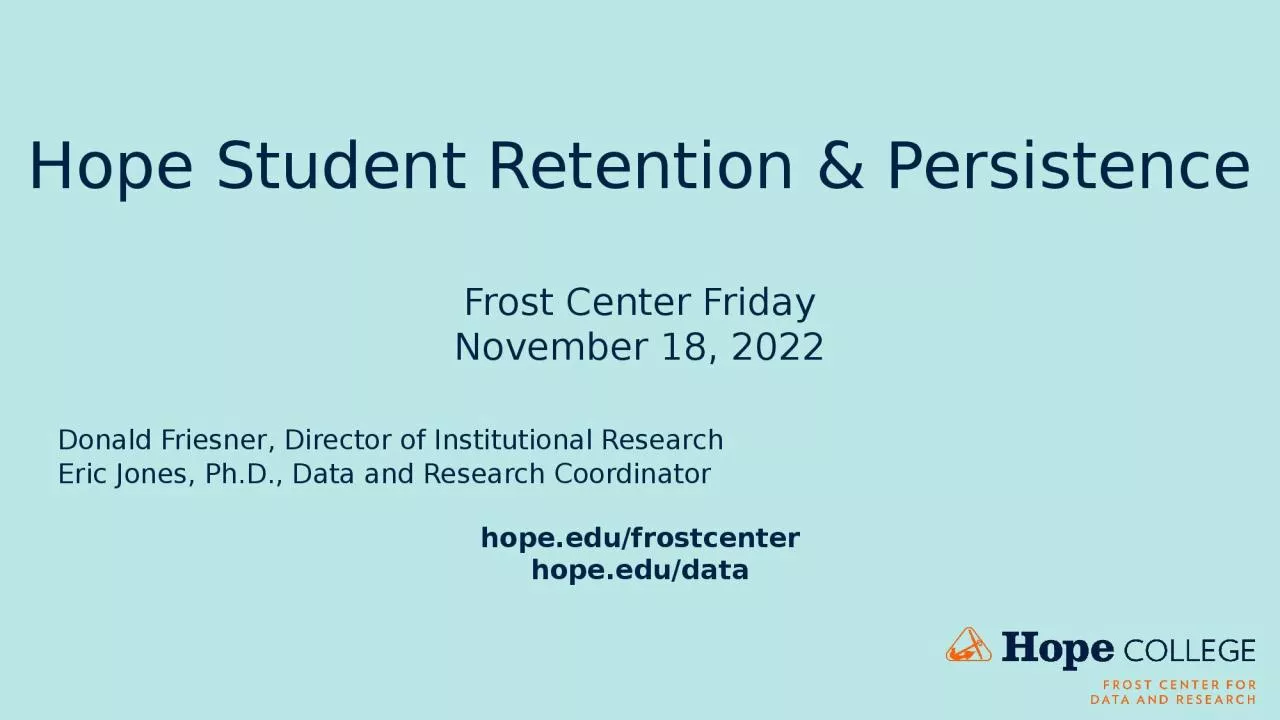

Frost Center Friday November 18 2022 Donald Friesner Director of Institutional Research Eric Jones PhD Data and Research Coordinator hopeedu frostcenter hopeedudata Overview ID: 1001760
Download Presentation The PPT/PDF document "Hope Student Retention & Persistence" is the property of its rightful owner. Permission is granted to download and print the materials on this web site for personal, non-commercial use only, and to display it on your personal computer provided you do not modify the materials and that you retain all copyright notices contained in the materials. By downloading content from our website, you accept the terms of this agreement.
1. Hope Student Retention & PersistenceFrost Center FridayNovember 18, 2022 Donald Friesner, Director of Institutional Research Eric Jones, Ph.D., Data and Research Coordinatorhope.edu/frostcenterhope.edu/data
2. OverviewAnalysis includes students who met the following criteria:Cohort Term: F2016, F2017, F2018, F2019, F2020, or F2021Cohort Type: First time in any college (FTC) or FOCUSSample size = 4275Demographic variables from BannerRaceGenderFirst-generation statusPell grant status at cohort termState (permanent residence)
3. OverviewData about which activities students were involved in from BannerASUBSUCASADance MarathonGreek LifeHope CatholicsHIYALSOMusicNykerkOrientationPASAPhelps ScholarsPrismThe PullSpring Break Immersion TripSOARAthleticsStudent CongressBridgeWEOHAIC
4. OverviewRetention and persistenceCohortClass1-Year Retention2-Year Retention3-Year Retention4-Year Retention201608Class of 2020XXXX201708Class of 2021XXXX201808Class of 2022XXXX201908Class of 2023XXX202008Class of 2024XX202108Class of 2025XX = included in analysis
5. RetentionBy Demographics
6. What is Retention? How is it Measured?Cohort: “The group of students entering in the fall term established for tracking purposes. For the Graduation Rates component, this includes all students who enter an institution as full-time, first-time degree or certificate-seeking undergraduate students during the fall term of a given year.”National Center for Education StatisticsRetention Rate: “A measure of the rate at which students persist in their educational program at an institution, expressed as a percentage. For four-year institutions, this is the percentage of first-time bachelors (or equivalent) degree-seeking undergraduates from the previous fall who are again enrolled in the current fall.” National Center for Education StatisticsRetention Calculation: Cohort grads + Returning Cohort/(Cohort - Exclusions)(Death, Permanent Disability, Military Deployment, Official Church Mission)
7. Retention by Gender
8. Retention by Race
9. Retention by Gender and RaceFemaleMale
10. Retention by First-Gen and Pell Status
11. Retention by Race, First-Gen, and Pell StatusStudents of ColorWhite
12. Retention by Race and State (Permanent Residence)Students of ColorWhite
13. Retention by First-Gen and Pell StatusFrom MichiganFrom Midwest (IL, IN, OH, WI)From Other State
14. Regression AnalysisSUMMARY OUTPUTRegression StatisticsMultiple R0.169018011R Square0.028567088Adjusted R Square0.027638376Standard Error0.355492335Observations4189ANOVA dfSSMSFSignificance FRegression415.549102173.88727630.759892.82644E-25Residual4184528.7521630.126375Total4188544.3012652 CoefficientsStandard Errort StatP-valueLower 95%Upper 95%Intercept1.0162079830.0215007347.2638800.9740551341.058360833Race 0.0327511120.0117990322.7757460.0055320.0096187430.055883482Gender 0.0533505840.0113265074.7102422.55E-060.0311446150.075556553PELL 0.0318593740.0150407952.1181980.0342170.0023714280.061347321First-Gen0.1228451140.0166697137.369362.05E-130.0901636230.155526605
15. National Student Clearinghouse SummaryDescription5 Year AverageFour-year degree from your institution599.8Two-year degree from your institution0Certificate from your institution0Four-year degree from other institution69Two-year degree from other institution16.2Certificate from other institution9.2Retained at your institution2702.8Retained at other four-year institution272.4Retained at other two-year institution147.2
16. What Happens to Non-Retained Students?Of those not retained over the past 10 years, 724 went on to get undergraduate degrees (Certificate, Associate, or Baccalaureate). Top Ten Transfer-Out CollegesCollege NGRAND VALLEY STATE UNIVERSITY85MICHIGAN STATE UNIVERSITY40UNIVERSITY OF MICHIGAN28WESTERN MICHIGAN UNIVERSITY26FERRIS STATE UNIVERSITY20CENTRAL MICHIGAN UNIVERSITY14GRAND RAPIDS COMMUNITY COLLEGE14WASHTENAW COMMUNITY COLLEGE12DAVENPORT UNIVERSITY11OAKLAND UNIVERSITY11UNIVERSITY OF ILLINOIS @ URBANA11Total 187Source: National Student Clearinghouse
17. RetentionBy Student Activities
18. Retention by Race and Participation in CDI Student OrganizationsStudent Organizations: ASU, BSU, LSO, PASA, Prism, HAIC**Fewer than 20 students in some cells, so results may not be reliable
19. Retention by First-Gen/Pell Status and Participation in CDI Student OrganizationsNo InvolvementInvolvement in at Least 1Student Organizations: ASU, BSU, LSO, PASA, Prism, HAIC**Fewer than 15 students in some cells, so results may not be reliable
20.
21. Retention by Race and Participation in Greek Life**Fewer than 5 students per cell, so results may not be reliable
22. Retention by First-Gen/Pell Status and Participation in Greek LifeNot in Greek LifeInvolved in Greek Life
23.
24. Retention by Race and Participation in Athletics**Fewer than 15 students per cell, so results may not be reliable
25. Retention by Race, Gender, and Participation in AthleticsFemaleMale
26. RetentionBy Activity Count
27. Retention and Number of ActivitiesActivity Count1-Year2-Year3-Year4-Year088.0%84.2%85.2%84.6%187.3%81.0%79.2%77.0%294.6%89.2%86.7%86.2%396.4%92.1%89.3%87.0%497.8%95.5%93.5%92.9%598.8%98.8%97.3%93.8%6100.0%96.8%96.4%90.0%7100.0%100.0%80.0%100.0%8100.0%100.0%100.0%0.0%9100.0%100.0%100.0%100.0%Only 1-5 students per cell in these rows
28. Key observationsIn general, retention rates were lower for:Male studentsStudents of ColorFirst generation students with Pell grantsStudents involved in campus activities tended to have higher retention rates, but there were some exceptions for The Pull, athletics, and student congress.With a sweet spot in the range of 4-6 activitiesFirst-Gen and Pell students who were not involved in student activities, did worse than others.The majority of students not retained are continuing their education elsewhere. While these students are a loss to Hope, their education here, is not.
29. Discussion, conversation, questions Who at Hope College (positions or departments) would benefit from the information shared today? Thinking about your own work at Hope, how might you use what you’ve learned today?How might data from this survey continuously inform decisions to benefit Hope students?